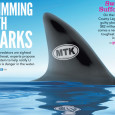
Bill Painter simply wanted the truth.
About four years ago, the now 50-year-old bayman pulled his skiff near one of the flags delineating shellfish beds the public can harvest in Oyster Bay and those leased from the town by Frank M. Flower & Sons, a commercial shellfishing company, and dug for clams. “Working the line,” he says, unfailingly attracted security boats and inspections of his haul.
Like clockwork for the next several days, Flower’s hydraulic suction dredges worked the exact same spot, though with a slight difference, according to Painter, one of roughly 70 remaining baymen who still literally scratch a living raking hard shell clams and oysters from the bottom of the harbor.
“The lines always looked different,” he says.
Convinced the oyster company had moved the flags separating the grounds—Flower is not permitted to harvest naturally occurring shellfish from public grounds—Painter hailed one of its ship captains and explained his plight.
“‘You know, Billy, you’re right,’” he recalls the captain telling him. “‘[But] if I call the office right now and tell them to come out, you’ll probably lose more grounds.’”
Painter then appealed to the town’s bay constables, who police the harbor and monitor whether baymen are poaching clams or oysters from Flower’s beds, issuing hefty fines to violators. Painter figured a quick check of the marker’s official GPS coordinates would prove his case.
Problem was, he soon discovered, the bay constables didn’t even have the coordinates. Thus began Painter’s quest for the critical data, until just recently, when one of several New York State Freedom of Information Law (FOIL) requests he filed with the town in 2011 was finally answered. Well, sort of.
Painter says the numbers are inaccurate, but supplied them to the bay constables, anyway.
His struggle to obtain the coordinates sparked an ongoing $750 million lawsuit filed in June 2011 on behalf of the North Oyster Bay Baymen’s Association against Flower, the Town of Oyster Bay and the State of New York, alleging a laundry list of fraud, illegalities, noncompliance and misdeeds spanning the past two decades, after a settlement was hammered out to resolve a 1991 lawsuit filed by baymen alleging many of the same claims made in the most recent complaint.
VIEW OUR “CLAM WARS” MULTIMEDIA PRESENTATION, INCLUDING MORE IMAGES AND VIDEO AT www.longislandpress.com/clamwars
The current litigation paints an unflattering portrait of a company and town perhaps best known for their popular annual oyster festival, which last year drew more than 200,000 people. Flower and Sons, the last of the old, big oyster companies that once dominated the Eastern Seaboard and the only one left in operation not just on Long Island, but in the state, provides the oysters.
Among the baymen’s more damning claims: that the mammoth Flower has been illegally harvesting naturally growing clams and oysters from both leased underwater lands and those that are lawfully only open to the public; that its fleet of hydraulic dredge boats and hydraulic suction dredges have been wreaking havoc on what is recognized as a National Wildlife Refuge; and that the only party privy to the actual coordinates of leased shellfish boundaries, until recently, was Flower, which has also been staking the boundaries of the very territory it leases.
Besides restitution, the baymen’s suit seeks that leases of underwater shellfish grounds between the town and Flower be declared null and void. It seeks an immediate end to Flower’s use of hydraulic dredges until an environmental review analyzes the techniques’ ramifications to the marine ecosystem, and it is deemed safe to continue. It seeks that Flower adhere to the mandates of a 1992 settlement agreement from their original litigation and demands an end to Flower employees’ alleged practice of replacing and marking their own shellfish beds, which the complaint argues under state law only certified land surveyors are permitted to do.
The complaint also demands the town comply with multiple FOIL requests for information filed by Painter that seek, among other data, details of the town’s current lease arrangements with the company for the lucrative shellfish beds—which net the company between $20 million and $50 million annually, according to Manta, an online business directory and network—as well as details of its lease with Flower for a roughly 6-acre prime parcel of town-owned waterfront property known as Oystermen’s Dock. The baymen want to know exactly how much Flower is paying per acre and how much the company has been paying for lease of the dock, where it stores its fleet.
On that topic, a FOIL request came back saying: “The results of our search reveal there are no such records,” which the baymen interpret as the town giving prime waterfront public lands to the corporation, for free.






